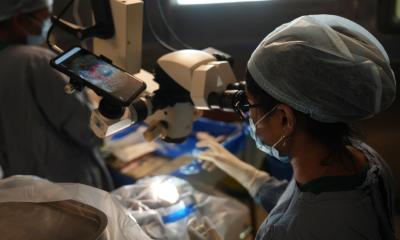21st Century lab automation
David Loshak outlines the impact of rapidly increasing mechanisation on the work of hospital lab technicians, researchers and industry
Laboratory automation of the 21st century demonstrates, every second, that in the 30 years since labs took their first tentative steps towards automation it has advanced by orders of magnitude - and moved far beyond the ambitions of its progenitors. Driven by the imperatives of greater efficiency, more precision and round-the-clock operation, ever more sophisticated forms of automation are now widely applied in discovering new medicines, enhancing productivity, reducing error, accelerating research, standardising processes, improving safety.
Innovations in robotics and information technology have transformed research. In the search for new medicines, automated laboratories use robots to manipulate, store and retrieve titre plates; in cell culturing and pharmaceutical research, they undertake specialised forms of material handling with the loading and unloading of test tubes in autoclaves as well as liquid-filled vials, flasks and bottles. Robots in hospitals fill prescriptions, improve the security of pharmaceuticals and reduce mistakes in preparing prescriptions.
Automation also helps to meet stringent demands for rapid patient testing without compromising safety – the laboratory staff has minimal contact with specimens. Tests that require 17 steps in conventional laboratories take nine with system-based automation, five with discrete automation and three with integrated automation. Laboratory directors can justifiably claim that at least three quarters of clinical decisions hinge on good lab information. ‘And we have eliminated the unpredictability of our lab service,’ adds Dr Kenneth Blick, director of clinical oncology at Oklahoma University Medical Centre. ‘We have gone from 18% outliers on our turnaround time targets to less than 5%.’
An iconic instance of modern laboratory automation is provided by liquid handling, a key to drug discovery because most experiment entails definite volumes of reagents. Handling low volumes, calibration, integration and liquid detection are key features of automated liquid handling systems. Hand-held automation devices, such as single and multi-channel pipettes, have hugely affected lab productivity because they permit dispensing into microtitre plates, or microplates, the standard tool in analytical research and clinical diagnostic testing, best known for its use in the enzyme-linked immunosorbent assay (ELISA), the basis of most modern medical diagnostic testing.
Efficient automated liquid handling systems have led directly to miniaturisation of assays. Today’s drug discovery is based on HTS – high-throughput screening – which uses robotics, data processing, liquid handling devices and sensitive detectors so that researchers can conduct millions of biochemical, genetic and pharmacological tests that rapidly identify active compounds, antibodies or genes that modulate particular biomolecular pathways.
‘The ability to do half a million test points in only one day has opened up new strategies in exploring drugs,’ says Kevin Hrusovsky, CEO of the US corporation Caliper Life Sciences. He notes that because plate formats can lower the volumes of samples needed to sub-microlitre amounts, the cost of reagents is much less. Although moving and measuring small quantities of fluids presents challenges, automated liquid handling does allow precise measurement of amounts as little as one nanolitre (a hundred millionth of a litre). ‘That not only permits scientists to use tiny quantities but means that fewer repeat tests are needed because the equipment confirms when the right quantities are dispensed.’
The results of such experiments provide starting points for drug design and for understanding the interaction or role of particular biochemical processes. Following genome sequencing and the emergence of genomics, life scientists have developed proteomics, the new science of the complex structures of living cells and how they function. This has disclosed huge numbers of new targets which have potential as drugs, far too many for researchers to study with old manual methods. Thus, HTS has become a key element in modern drug discovery. No wonder the laboratory automation equipment market in Europe alone is now worth some ?200 million.
Effective HTS relies on efficient information management systems to deal with the data it generates. ‘Typical large pharmas today are generating 20 terabytes of data daily and that will soon rise to 100 terabytes,’ according to John Helfrich of Massachusetts-based NuGenesis Technologies Corporation. A good data system, he explains, handles the capturing, loading, sorting, querying and viewing of information from both biological and chemical perspectives and also needs the flexibility to scale up with increasing HTS capacities. ‘Our scientific data management system is an application-independent, web-enabled platform for collecting, storing and managing scientific information. The system captures the essence of reports,’ he adds. ‘We put a print driver on the instruments and capture the contents of their information. The value of that is that it is information source independent. A scientist does not need mass spectrometry or chromatographic software to capture the data from those instruments. Any scientist at the lab bench who has security approval can look at those reports, extract what he or she needs from them and send them on.’ The system thus fosters high levels of teamwork and drives up the pace of decision-making in many areas of drug R&D.
Although there are laboratories that still need to work out how best to use automation most efficiently, such problems are minor compared to the potential of lab automation, declares Tony Beugelsdijk, chairman of America’s Association of Laboratory Automation. ‘Integrated library management is coming along – we will probably see formats that enable libraries to become part of an HTS system, miniaturised beyond what we see today.’ The results of screening enabled by lab automation would become available to more scientists than in the past. Manual scoring of crystallisation experiment images would be replaced by computational scoring.
Indeed, the automation of X-ray crystallography provides a paradigm of how laboratory automation evolves.
First come efforts to automate manual procedures. While these often work well, they do not always translate well enough, so processes are re-engineered to take better advantage of automation. Then, other snags and challenges emerge and are addressed.
But the bottom line, as Americans, who lead the world in laboratory automation are fond of saying, is that lab automation increasingly gives scientists authentic freedom. ‘Scientists do science best; instrument companies do instruments,’ says Joan Stevens, of Gilson Inc. of Wisconsin, US, makers of automation instrumentation and chromatography systems. ‘Together, we make a very nice package.’
01.07.2008










